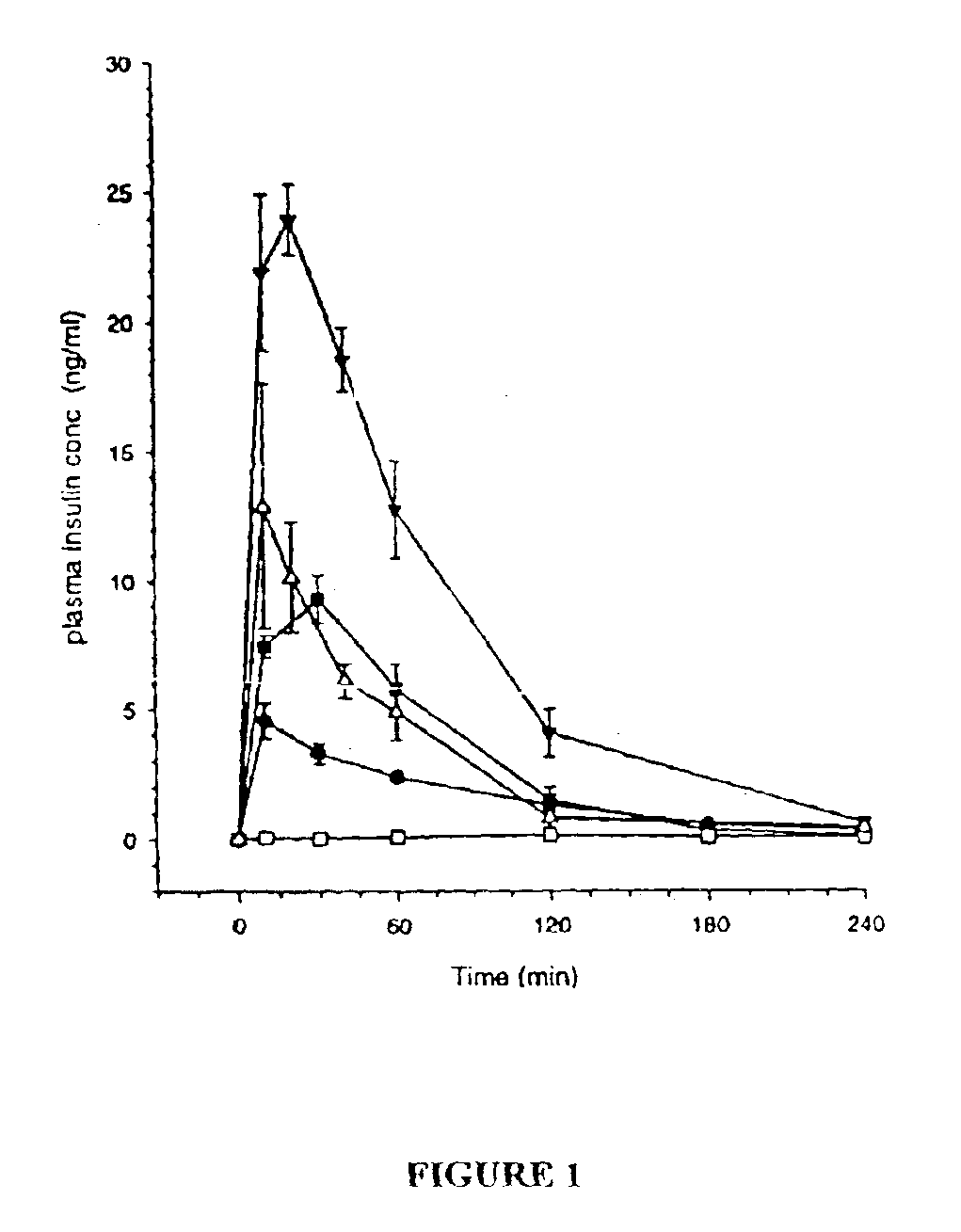Hydrogel particle formulation
- Summary
- Abstract
- Description
- Claims
- Application Information
AI Technical Summary
Benefits of technology
Problems solved by technology
Method used
Image
Examples
example 1
[0136]The objective of this example is to evaluate the performance of insulin delivery following the administration of insulin-loaded, powdered agarose bead compositions of this invention and to compare insulin relative bioavailability (to subcutaneous injection) following administration of standard lyophilised and agarose bead insulin powdered formulations via high velocity transdermal delivery to mice. The overall approach was to administer a 1 mg dose of powdered insulin formulation to an anaesthetised rat (n=4-6 rats for each formulation) using a dermal PowderJect® needleless syringe device (PowderJect Technologies, Limited, Oxford, UK). Two agarose bead compositions of this invention were compared to a standard lyophilised insulin powder formulation. Arterial blood samples were collected periodically following administration of each dose, and insulin and glucose concentrations were determined. Insulin pharmacokinetics and glucose dynamics following transdermal particle injectio...
example 2
[0187]This example sets forth a composition of this invention and a process for its preparation. The particular active (guest agent) was lactate dehydrogenose (LDH) and the hydrogel was agarose (Bio-Gel A15M).
[0188]Lactate dehydrogenase (LDH) was obtained from Sigma Chemicals (L1254; Lot 96H9568). Bio-Gel A15M was obtained from Bio-Rad (Cat. No. 151-1050) as a powder having a MMAD of 20-150 μm. LDH activity was measured using an endpoint, colorimetric assay (Sigma No. 500). All other reagents were obtained from Fisher Scientific and were ACS-grade or better.
[0189]The Bio-Gel A15M resin was washed with water to remove preservative and then poured into a disposable 1×10 cm column to a final column volume of approximately 5 mL. The column was equilibrated with 5 mL sodium citrate, pH 6 containing 5% (w / v) mannitol. LDH was dissolved in the same buffer at 2 mg / mL final concentration. A 5 mL sample of this solution was loaded to the column and allowed to fully penetrate.
[0190]The resin w...
example 3
[0193]Two calcitonin formulations: calcitonin / trehalose / mannitol (8 / 52 / mannitol, q.s.a.d.)±3% of poly(N-isopropylacrylamide) are used as the model hydrogel with the total solid concentration at 20%. The liquid formulation (10 mL) is atomized using an ultrasonic atomizing system (frequency at 60 kHz) into a tray of liquid nitrogen. The resulting ice droplets / liquid nitrogen mixture is placed in a freeze dryer pre-chilled at −50° C. The dryer is warmed to −25° C. in 1 hour and maintained at −25° C. for one hour with a vacuum pulled at minimum 0.1 mbar. The primary drying is then continued at a ramping temperature profile (increasing from −25° C. to 0° C. over 30 hours). At the end of the primary drying, the temperature is increased to 20° C. in an hour and maintained at 20° C. for another 12 hours for the secondary drying. After drying, a volume comparison of the two powder formulations at the same sample weight shows that the hydrogel-containing formulation has less volume, indicatin...
PUM
| Property | Measurement | Unit |
|---|---|---|
| Fraction | aaaaa | aaaaa |
| Fraction | aaaaa | aaaaa |
| Fraction | aaaaa | aaaaa |
Abstract
Description
Claims
Application Information
 Login to View More
Login to View More - R&D
- Intellectual Property
- Life Sciences
- Materials
- Tech Scout
- Unparalleled Data Quality
- Higher Quality Content
- 60% Fewer Hallucinations
Browse by: Latest US Patents, China's latest patents, Technical Efficacy Thesaurus, Application Domain, Technology Topic, Popular Technical Reports.
© 2025 PatSnap. All rights reserved.Legal|Privacy policy|Modern Slavery Act Transparency Statement|Sitemap|About US| Contact US: help@patsnap.com



